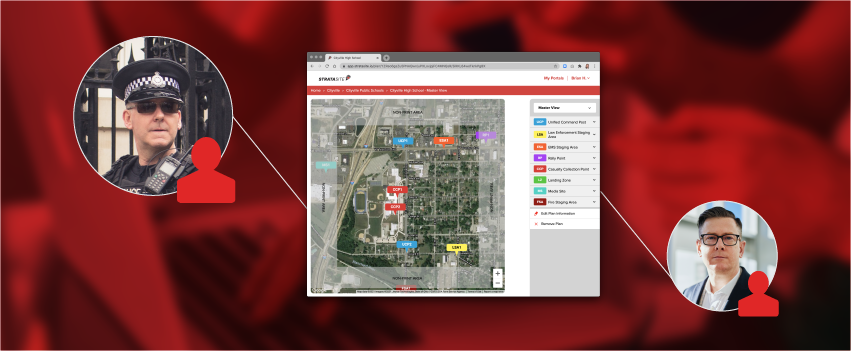Workplace safety should be the top priority for your business—no matter what industry you’re in. Organizations that are considered hazardous workplaces, though, need to take extra precautions to maintain overarching safety and well-being.
Hazardous materials have the ability to harm people, the environment, infrastructure and property, making them a critical area to prepare for. In fact, according to the Environmental Protection Agency (EPA), “recent evidence shows that many people consider hazardous materials incidents to be the most significant threat facing local jurisdictions.”
If your organization handles hazardous materials or is considered to be a hazardous workplace, there are distinct considerations that must be addressed to ensure adequate preparedness. That’s where a hazard mitigation emergency preparedness plan helps.
“Even if you are not specifically required to do so, compiling an emergency action plan is a good way to protect yourself, your employees and your business during an emergency.”
-The Occupational Safety and Health Administration
According to the Occupational Safety and Health Administration (OSHA), at a minimum your plan needs to include:
- A preferred method for reporting fires and other emergencies
- An evacuation policy and procedure
- Emergency escape procedures and route assignments, such as floor plans, workplace maps and safe or refuge areas
- Names, titles, departments and telephone numbers of individuals both within and outside your company to contact for additional information or explanation of duties and responsibilities under the emergency plan
- Procedures for employees who remain to perform or shut down critical plant operations, operate fire extinguishers or perform other essential services that cannot be shut down for every emergency alarm before evacuating
- Rescue and medical duties for any workers designated to perform them
By documenting the above and accurately strategizing for an emergency response, you’ll be better equipped to protect the safety of your employees and infrastructure. How can you most effectively identify the above, though, and which specific considerations need to be evaluated for optimal plan development?
Preparing a Hazardous Workplace Environment
When preparing a hazardous workplace for an emergency situation, there are a number of steps to take and intricate details to plan for.
Assemble Stakeholders
A multisector team is key for plan coordination and development. Receiving input from multiple departments and areas of expertise, including both management and employees, will help get a full scope of what your organizational needs are.
The Federal Emergency Management Agency (FEMA) suggests that, as applicable, you should include representatives from:
- Maintenance
- Operations or line personnel
- Upper and line management
- Legal
- Fire and HAZMAT response
- Environmental, health and safety affairs
- Training
- Security
- Public relations
The scope of this team can scale based on the size of your organization—or the extent of risk of hazardous threats.
You’ll also want to coordinate with local emergency service responders, including the fire department and HAZMAT, who will assist in supporting during an actual emergency situation.
By allowing everyone the opportunity to provide input on the plan, you’ll be successfully suited for a multidisciplinary response.
Assess Possible Risks
You need to understand what your plan has to be prepared to address. By conducting a comprehensive risk assessment, you can fully:
- Identify hazards or potential risks that can cause harm
- Evaluate the risk associated with each hazard
- Determine how to eliminate or control the risk
By evaluating and identifying the above, your organization will be better equipped to address potential hazards—and protect your most vulnerable employees.
You’ll also want to ensure that you conduct this assessment on a routine basis. If your organization is consistently changing protocols or materials, ensure you communicate with the appropriate personnel to have those changes reflected in your response plan.

Assign Roles and Responsibilities
During a hazardous materials emergency situation, many roles will need to be filled—both within the facility and in the response teams.
FEMA acknowledges that “given the large number of personnel at the site, roles and responsibilities must be clearly established in the contingency plan before the incident occurs.” A hazardous incident can draw response from a variety of individuals, including firefighters, police and emergency medical technicians. In a Florida chemical incident, approximately 200 officials responded to the scene; that number does not even include those handling the actual cleanup.
Hazardous incidents are more complex than other emergency response needs, so there may also be specially trained personnel on the scene. The media will also play a role in the response, as they will be on-scene working to get the latest updates.
Role assignments specifically include documenting the incident commander, who typically is a representative from the local fire department. The incident commander will help with the successful management of the emergency response during a hazardous materials incident and is responsible for directing operations to align with the emergency operations plan. When other high-ranking officials arrive on scene, they may try to take on the role of incident commander; however, a well-documented plan can eliminate confusion over who is fully in charge during an emergency—helping better coordinate the response.
By clearly identifying who is responsible for each necessary task, you’ll improve efficiencies during an emergency response.
Determine an Alert System
When a hazardous situation occurs, alerting all potentially impacted individuals as soon as possible is key. Determine who is responsible for this alert—and what the alert should be. Do you want your security team to set off a facility-wide alarm? Should an automated text message be sent to every employee? It’s important to identify early on how you want employees to be alerted about the emergency situation and who is responsible for this task.
You’ll also want to determine a streamlined alert plan for outside emergency services, as well.
Keep in mind that human error can occur during an emergency response, so it’s worth determining which types of automation can be input into the protocols to help alleviate those concerns and ensure all relevant stakeholders are alerted promptly.
Coordinate Assembly Points
Once your employees are safely out of the building, they need to understand where to go to not only be safe—but also stay out of the way of the emergency responders. Set up assembly points outside so that employees know where to safely go and receive any medical attention, as applicable. Assembly points will also help with confirming that all personnel have vacated the building accordingly, helping limit the risk of employee harm.
OSHA recommends designating evacuation wardens who will direct people into safe areas during an emergency situation. One warden per every twenty employees is advised, and it’s imperative that the correct number of wardens is available during all work hours.
By having these set points—and specifying roles like evacuation wardens —you can ensure that employees have a clear understanding of their appropriate actions during the emergency response.
Plan for Access to Resources
A hazardous situation calls for unique safety equipment, including essential protective gear like respirators, protective clothing and eye protection. Depending on the type of hazardous situation, protective equipment recommendations may vary, so it’s important to understand what is needed for each potential emergency—and have the right equipment readily available.
Make sure that your organization is prepared with the correct materials or has already partnered with first responders in ensuring they have the proper equipment. You’ll also want to pinpoint where this equipment will be stored within your worksite; this location should be incorporated into your emergency preparedness plan so that all relevant personnel know the access points.
Prioritize Regular Training
As regulations become more effective, the number of hazardous materials incidents has decreased; this has led to a decline in hazardous response needs from first responders, decreasing active training opportunities. As a result, there are fewer opportunities to build emergency situation decision making, as well as less familiarity with functioning while wearing personal protective equipment.
To help counter this, FEMA notes the importance of prioritizing effective, risk-based training, as this will help better prepare first responders to handle hazard mitigation situations. Ensure that the appropriate responders have the opportunity to train in productive, realistic setups at your facility to better engage their preparedness education.
Additionally, routine training is imperative within your own organization. Your plan is only effective if all personnel know how to accurately execute it.
Consider performing training when you:
- Hire new employees
- Add new equipment, materials or processes that can impact evacuation routes
- Adjust the layout of the facility
- Revise overarching emergency procedures
Your organization could also consider investing in a learning management system (LMS) that provides real-time, online training for relevant personnel. By integrating an LMS into your protocols, you can identify weaknesses or shortcomings within your organization’s plan and immediately adjust your planning and training protocols accordingly.
You’ll also want to include an accountability aspect into all training. While you don’t necessarily need to focus on pass or fail, you do want to ensure that all relevant stakeholders are accessing the plan and reviewing it. This could be set up through something simple like online quizzes or through an email that people must be complete.
By prioritizing training and investing in the needed technology to support comprehensive training, you’ll be best prepared to address an emergency when it arises.
Review Your Plan
Operations and needs will change—and your preparedness plan should change, too.
At least once per year, complete an assessment of potential risks and ensure that your plan addresses all of them. If you’ve had operational changes in the previous year, take those into consideration as you adapt your plan.
Keep in mind that if anything changes significantly—including new materials or changes in processes—you should address your preparedness plan immediately instead of waiting for the annual review period. By delaying adjustments to the plan, you could find yourself facing a hazardous situation without an understanding of how to respond. Take the time to stay informed on organizational or personnel changes that could impact your plan, then update your response plan accordingly.
By investing in collaborative technology for your preparedness planning, you will be better equipped to make real-time changes to your hazard mitigation plan, helping keep your organization prepared.
Invest in a Collaborative Response Solution
StrataSite™ is your solution for hazard mitigation.
As a secure, cloud-based preparedness tool, StrataSite enables project leaders to easily pinpoint and annotate action points, including:
- Work areas
- Hazardous materials zones
- Contamination and decontamination areas
- Site perimeters
- Rally and access points
- Evacuation routes
Through this comprehensive, collaborative solution, your organization can efficiently plan and train for increased safety and compliance within hazardous work environments.
“The StrataSite hazard mitigation plan is a comprehensive resource for addressing most of the moving parts associated with safety planning and training around a potentially hazardous worksite.”
-Health and Environmental Safety Officer
Sign up for your free, no-obligation trial of StrataSite today.


